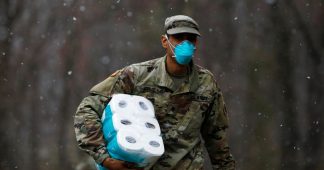By Andre Damon, David North
Dec. 9, 2020
By way of comparison, during the 1918 “Spanish flu” pandemic, some 675,000 people in the US lost their lives over two years, an average of less than 1,000 people every day. In 1995, at the height of the horrific AIDS epidemic, 41,000 people died in a single year, amounting to approximately 112 people per day, or 1/20th the current rate of death.
Within the next few days, the total death toll from the coronavirus will surpass 300,000, or nearly one out of every 1,000 people in the entire country. The coronavirus is now the leading cause of death in the United States, surpassing heart disease and cancer.
Under conditions in which this level of death occurs day after day, week after week, month after month, the official response is to minimize the catastrophe that is unfolding.
Death has been “normalized.”
In the media, the death toll is reported every day. There is even, from time to time, reference to some particularly ghastly incident, such as the death of both parents or the wiping out of a family. But the subject is dropped, and the newscast moves on to the next item. There is no acknowledgment that this unmitigated catastrophe requires a massive and immediate response. There is no attempt to examine who is dying, where and under what conditions.
Trump, the fascistic would-be dictator in the White House, has treated the deaths as of no significance— “virtually nobody” is affected, as he put it earlier this year. The entire policy of the Trump administration has been based on preventing any coordinated response to stop the spread of illness and death.
As for President-elect Joe Biden, he casually observed last week that “we’re likely to lose another 250,000 people dead between now and January.” He presented this massive death toll as if it were an unavoidable cosmic event, requiring no immediate action. There was no demand for emergency action to prevent this forecast from being realized. Yesterday, Biden outlined his coronavirus policy, centered on the demand that schools must remain open, which is seen by the ruling class as essential in keeping workers on the job.
The normalization of death arises from the decision, rooted in class interests, to treat “economic health” and “human life” as comparable phenomena, with the former prioritized over the latter. Once the legitimacy of the comparison and prioritization is accepted—as it is by the political establishment, the oligarchs and the media—mass death is viewed as unavoidable.
It is from this awful calculus that the slogan emerges, “The cure can’t be worse than the disease.”
Under capitalism, what is meant by “the economy” is the exploitation of the working class. To the extent that the “cure”—that is, the most elementary measures to save lives—impinges on the process of profit accumulation, it is unacceptable. Anything that undermines the extraction of surplus value from the working class, or diverts this surplus value from the capitalists through emergency measures and social services, must be rejected.
From thence the conclusion: Workers must die. When Marx refers to capitalism’s “blind unrestrainable passion, its werewolf hunger for surplus-labor,” these are not just literary phrases. They express the horror of social reality.
The response of the ruling class to the pandemic within the United States and throughout the world arises out of the conditions that preceded it. It has been nearly four decades since Ronald Reagan and Margaret Thatcher assumed office, proclaiming (in the words of Thatcher) that there is “no such thing as society.” The right-wing libertarian “free market” ideology peddled by Thatcher and Reagan became a staple of every part of the political establishment, embraced by Democrats like Bill Clinton and Labourites like Tony Blair. Their reactionary “free market” nostrums are the basis of capitalist policies in every country.
For decades, Democrats and Republicans alike slashed social spending and welfare programs, funneling ever greater sums into the financial markets. In the process, it was proclaimed, corporations not only had the rights of human beings, the interests of corporations—and the financial oligarchy—were elevated above human beings.
In a financialized world, in which human life has only an abstract economic significance, those who are not engaged in producing surplus value—and whose cost of care subtracts from the mass of surplus value produced by the expenditure of labor power—are “worthless.” Wherever calculations of profit and loss are made, the ghost of Malthus is always present.
From this basic class logic flows the policy that has been implemented: the downplaying of the threat of the virus, the massive bailout of the rich, the campaign to reopen the factories and reopen the schools. The predictable consequences of this policy are now unfolding.
There are other factors that compound the indifference of the ruling elite. The coronavirus pandemic is a disease that affects primarily the elderly and the working class. Covid-19 spreads rapidly in factories and in-person workplaces, disproportionately affecting the working class who live in shared and multigenerational households and often lack opportunities for social distancing.
In the United States, 80 percent of those who have died have been older than the retirement age of 66. Just five percent of the country’s Covid-19 cases have occurred in nursing homes, but these facilities have accounted for 40 percent of deaths, or more than 100,000 people.
But even the spread of the virus into the ruling class, and into the White House itself, has no effect on the response.
Stopping the pandemic and saving lives are inseparable from getting rid of the social order that produced the catastrophe. The senseless and preventable sacrifice of hundreds of thousands of lives is the greatest testament to the reactionary and inhuman character of the capitalist order, and the necessity for replacing it with socialism.
Published at https://www.wsws.org/en/articles/2020/12/09/pers-d09.html











